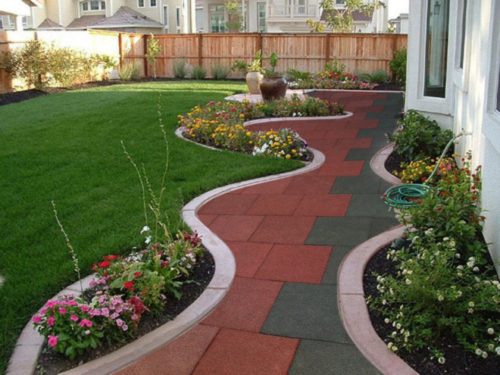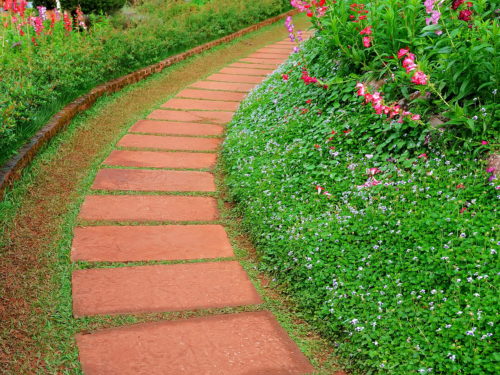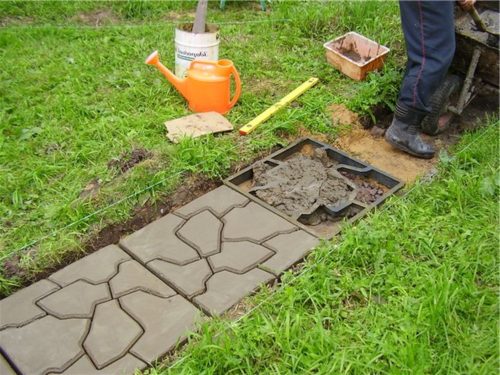The creation of garden tracks is the usual case for summer residents who wish to make a plot and attractive outwardly, and convenient for use.
Content
As practice shows, the main task when creating garden tracks is a savings that allows you to extract the highest quality result from a limited budget.
Fortunately, on the Internet, you can find a lot of options for creating garden tracks based on breed materials, but you can pay attention to the personnel arrangement of paths based on cement-sandy solution. It is necessary to make a lot of effort for a positive result, but it is worth it.
In this article, we will consider the main features of the creation of garden tracks based on concrete and the use of certain forms.
Types of garden tracks
- Failure. Probably? The easiest option associated with the creation of garden tracks is based on the backfill of a certain part of the territory of rubble. After the uniform distribution of the material, we get a flat track that will last long years and will remain in the same condition.
- Wood. Based on the tree, it is not so easy to create a path, especially if this part of the territory should also be attractive. The boards or bars are selected, after which their cutting is carried out and further installation. Everything else is the project costly in terms of money.
- Trail. The arrangement of the path often can become the most optimal solution, as we are talking about the minimum cash and the creation of conditions in which the track will be best combined with a green area. A stone can be used as restrictions, which would be located along the edges of the path.
- Flower. The essence of the creation of such a garden track is to implement the project based on a concrete mix. The soil is leveled, the base is prepared, after which the concrete is evenly poured over the future track. You can create peculiar boundaries, as well as use decorative elements with which the project will look more than presented.
- Paving tile. In each city, you can find quite a few manufacturers of paving slabs, based on which attractive garden track is created. It pleases that initially you can choose one or another version of the tile that is suitable for the project. Also, the tile can be created with your own hands.
Creation of garden lanes based on cement-sandy solution
It is confidently saying that on the basis of cement-sandy solution, more than attractive garden tracks are created, and below can be familiar with the main advantages of such a solution:
- Reliability. If the track is based on concrete, then this is a project that will serve for a long time, and please your appearance. Perhaps, with time, various cracks or other damage will appear. If a mixture is high-quality, and everything was performed clearly by technology, then no difficulties should be.
- Simplicity of tile manufacturing. The easiest thing is, of course, just buy a tile from one of the numerous sellers. It is worth paying attention to the fact that the transportation of the material happens quickly, in whatever point the site is neither. It is not so easy to produce a tile, as it may seem at first glance, but with this task, any person will be guaranteed to carefully analyze technology.
- Number of options. On the basis of the tile, you can create a variety of tracks, starting with color and ending with various patterns and other components of the appearance of the surface. Of course, within the framework of the tile, the tiles are best not to experience fate and produce the simplest variants of the material.
Tile manufacture
- It all begins with the acquisition of the necessary volumes of sand, cement and rubble (if necessary). It should be borne in mind that for one or another project there may be different volumes of material, so it must be relying on our own calculations.
- Also, if the volume of work is large, you need to have a concrete mixer or other large container in which the mixture will be remembered. It is necessary to observe the proportions of the components so that the mixture is the highest quality. The tile strength is controlled using the water and cement ratio, so it is desirable to read the documentation and get some consultations from specialists. A variety of plasticizers and other components can also be added to the mixture, which should help make the final material worthy of quality. As for dyes, they are also often used in such events. The amount of dye should not exceed 2% of the total volume of the material. After careful kneading, you can move to the next step.
- You need to decide in advance with the forms in which the mixture will be poured. You can find hundreds of tile options that will create a decent product. It should also be responsible to refer to the quality of the forms, as literally after the first actions, they may lose their basic properties.
- After pouring the mixture, the mixture should be sealing. The thing is that inside there may be various emptiness that will more than negatively affect the general quality of the material. It will begin to crack, and also just collapse under the action of harsh external conditions. Therefore, the main task here is to use vibration equipment. It is possible to create a vibrating table that has a directly surface for the material itself, from the bottom of the vibrating absorbent, and on the sides of the spring that perform the shock absorber function. When the installation starts, a small vibration will occur, which will make that there is no emptiness in the mixture, and ultimately, the tile will be suitable for use in the project. Under the action of the vibration table, the shape with the mixture must be within 20-30 seconds, after which the material should spend some time in protected conditions (under a canopy) before using it to create tracks. All this can escape a huge amount of time, but it all depends on the number of forms that can be used in the process.
Using a tile to create a garden path
- In this case, it is not necessary to have with you the same amount of tiles that are necessary to create the entire track. Perhaps the best solution will be the gradual implementation of the project, dividing the total work on several parts. First of all, the soil is prepared under the laying of the tile.
- It is most important to remember that the topmost layer of the soil, which at first glance may look quite decent, hides certain problems. It is emptiness, and total soil looser. To avoid problems under which the laid tile is simply falling into the ground, you need to remove the top layer of the soil - just a few centimeters. The surface should be as smooth as possible in order to be comfortable to move later on the track.
- As the basis for laying the tile, you need to equip a sand pillow. The width of this layer must correspond to the width of the removed soil. More than an important aspect of creating a sandy pillow is to provide high sand density. If the track has large dimensions, it is advisable to use a small manual roller, allowing the loss to the loss. Instead of sand, you can use fine crushed stone.
- Ultimately laying tiles. Here the most important thing is to ensure the dense location of the units of the material. The tile is placed on a specific pattern. Each unit of material beats with a rubber hammer, but should not be performed too strong blows, as the material is quite fragile. Even before starting styling, the tile makes sense to create a limit for the tile surface. Most often it is a border, which is bought into the ground, or is mounted on the basis of cement-sand mixture. With the created borders, lay the tile is substantially simpler.
- When creating a project, you need to consider in certain places the tile will have to cut into parts. Therefore, it makes sense to do everything in advance so that no difficulties in this process arise (the width of the track, pattern, etc.). At the very end of work, it is necessary to clean the surface from sand and contaminants, after which the track becomes completely suitable for operation.
Concrete Pouring for Garden Track
In the event that the manufacture of paving slabs in handicraft conditions is too hard, you can pay attention to an almost similar option of the track, but with the fill of the section cement-sandy mixture. The main advantage of this version of the work is in the overall simplicity of the process, since everything happens solely in one place.
- It all starts with the most preparatory work. A layer of soil is removed on which there are plants. Together with the roots need to be removed. It should be borne in mind that often such a layer is only a few centimeters, but in certain cases it is necessary to shoot more soil to ensure high quality of work. In the event that the depth of the soil drops is too large, you will have to spend on a sandy pad or on a layer of stone. For maximum convenience, the track has already been created either correspond to the level of soil, or be slightly higher. Otherwise, all pollution and precipitation will be collected on a path. You can try to remove the layer that matches the thickness of the material. However, with such a situation, there is a high probability of obtaining not the highest quality coverage.
- The next step is to create formwork. Its necessity is dictated to the fact that the fill of concrete will be carried out, so the formwork is a certain replacement of forms from the past variant of creating a track. The height of the formwork above the level of the soil should be about 5-7 cm. There is no longer any meaning, since the total strength of the track will not change, and there will be a lot of mixes to this matter. The formwork is often knocked out of the tree. In the manufacturing process, the strength of the material is checked, as well as the absence of significant flaws. If the path should be rounding, it makes sense to use the paneur of the appropriate form. Such elements are used along the edges of the track, but it is quite a fine work that requires care.
- As for the size of formwork, it is easiest to equip all wood design at once. However, it is important to remember that the fill of the mixture occurs in parts, since otherwise the probability of obtaining not the highest quality and reliable surface is large enough. In addition, between these most parts that form a formwork and the future garden track is divided, there must be a small gap that performs the function of compensating temperature extensions. In the event that the track is long and solid, then the surface is guaranteed to crack. Specialists are recommended to do so that the length of one fill sector does not exceed 2.5 m.
- Now comes the time to create a sandy pillow. It will allow you to evenly distribute the weight of the concrete surface, as well as this is a good tool to provide drainage. The moisture will be seamless to the sand pillow, thereby releasing the concrete structure from numerous negative factors. An important thing is also the question associated with the fact that the sand literally after a couple of seasons can simply go through the ground, and the most common soil will be under the garden path. To avoid this trouble, you should sit around the entire perimeter of the future garden track agroll. This material misses moisture well, but even a small sand fraction will remain in place. Also, agriched is not amenable to rotting, so the material will be rejected by its effectiveness for many years.
- After laying the agrofibling from above, sand is embanked. It is important to produce a sanding of sand, as even small empties can lead to significant problems.
- Now reinforcement happens. A layer of polyethylene film is stacked over the sand pillow. The need for a film is that the cement-sandy solution should not just dry, but to dial strength. The film will not give the material just to dry, therefore, ultimately the track will be optimal in terms of strength. Laying of fittings occurs in almost any way. It is not worth purchasing for this case. It is pipes, and hooks, as well as much more. If the track is too big, and such components are not so much, then the reinforcement will be quite a logical option.
- Preparation of the mixture for the fill occurs in the concrete mixer, or another capacity, if the volume of work is not the largest. Sand and cement ratio should be 1: 3. Also during the mixing process, water is used, but its volumes are calculated depending on the size of the track and the overall quality of the mixture. It is only necessary to knead the volume of the solution that will be involved at the moment.
- Directly the fill occurs with the help of the buckets. Small portions material flooded within the framework of formwork. From above, you can arrange special forms that will create an invoice for the surface. Immediately after the solution began to grab a little, you can arm yourself with the rule and to dissolve the surface. There is no need for this, however, such a solution will allow several improvement of the appearance of the surface if it should be perfectly smooth. After pouring to the surface, a polyethylene film is placed, which will protect the mixture from external factors. Moreover, this option will allow to obtain a better surface.
Ultimately, if everything is done clearly by technology, the track will serve for a long time. An excellent indicator of the quality of the garden path is the winter period, during which cracks often appear and similar damage. If weight comes, the snow goes down, and there are no flaws on the surface - everything was done correctly. However, sometimes it is not so easy to protect yourself from problems. If the cement was poor-quality, or the ratio of sand, cement and water was not the most successful, then cracks and other problems can make themselves felt. The solid surface on the basis of cement-sandy solution is always a big responsibility.
























